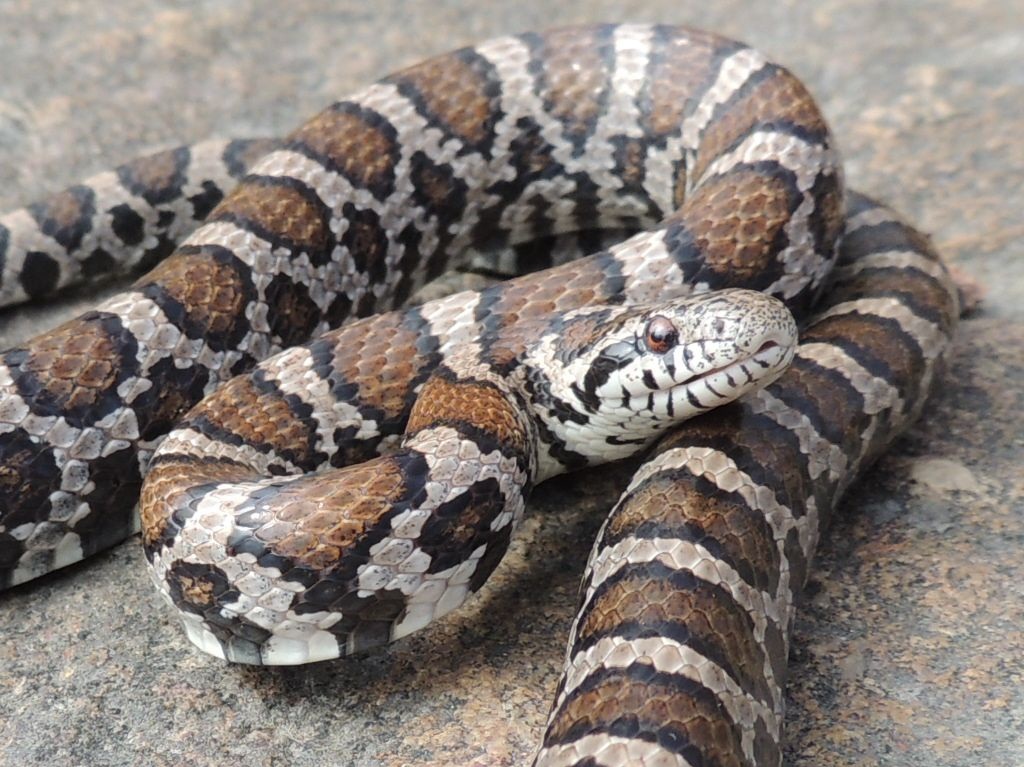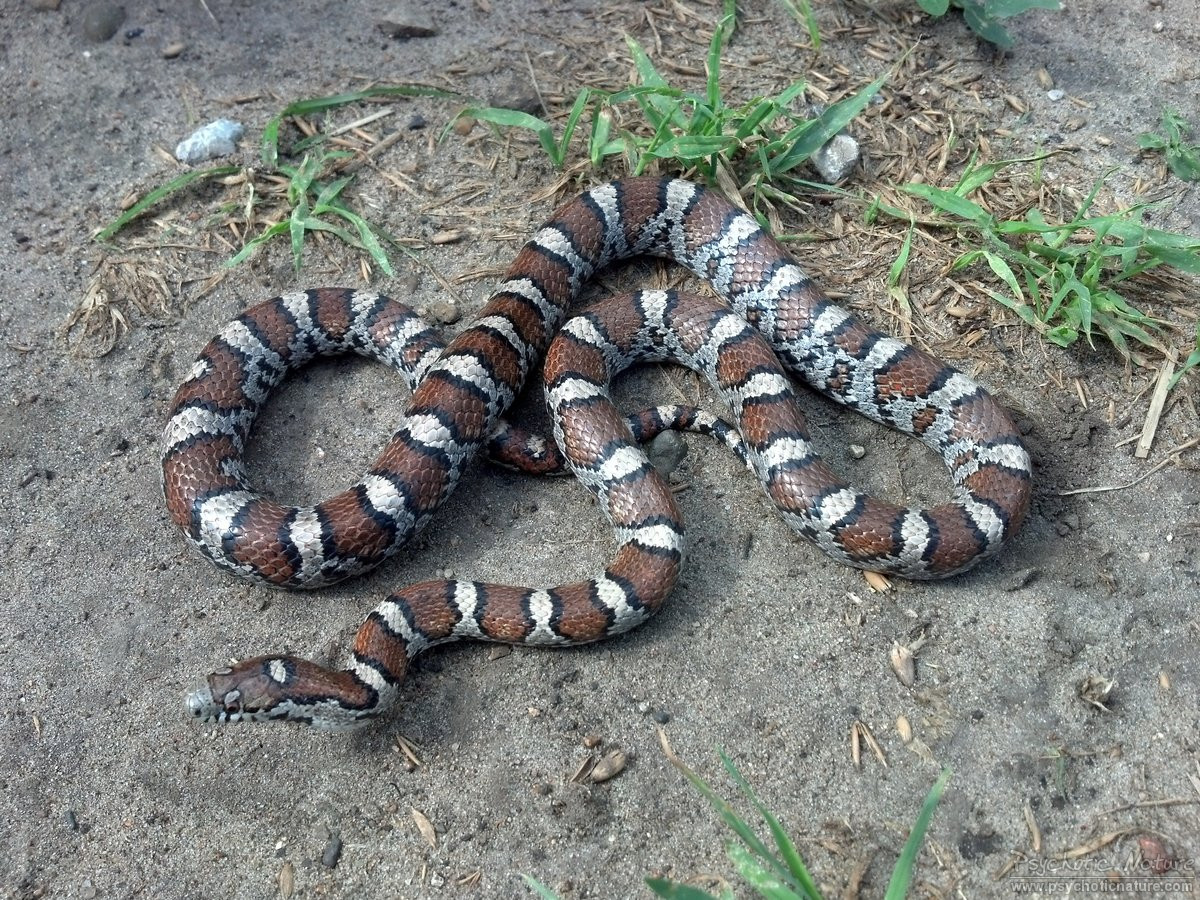Eastern Milk Snake: Unraveling The Mystery Of This Harmless Mimic
Scientific Classification and Subspecies
To truly understand the eastern milk snake, it's essential to begin with its place in the biological world. The scientific name for the eastern milk snake is *Lampropeltis triangulum*. It belongs to the family Colubridae, which is the largest family of snakes, encompassing a vast array of nonvenomous species. The genus *Lampropeltis* is commonly known as kingsnakes and milk snakes, a group celebrated for their constricting abilities and often vibrant patterns. Within North America, eight subspecies of *Lampropeltis triangulum* are currently recognized. While the eastern milk snake itself is a distinct subspecies, it's important to note that its range can overlap with or be adjacent to others. For instance, in Illinois, two subspecies are known: the eastern milk snake (*L. t. triangulum*) and the less brightly colored subspecies (*L. t. syspila*). This taxonomic diversity highlights the wide genetic variation within the species across its broad geographic range. Understanding its classification helps herpetologists and enthusiasts alike to differentiate between various populations and study their unique adaptations.Geographic Range and Habitat
The eastern milk snake boasts an impressive geographic distribution, making it one of the more common snakes found across a significant portion of North America. Its range extends from Maine in the north, stretching westward into Ontario, Canada. To the south, its territory reaches down to Alabama and North Carolina. This wide distribution means that the eastern milk snake adapts to a variety of climates and ecological zones. Historically, there was some debate among herpetologists about whether the eastern milk snake intergraded with the scarlet kingsnake (*Lampropeltis elapsoides*) in parts of its southern range, but this theory has since been disproved. This clarification helps in accurately mapping the distinct territories of these similar-looking species. When it comes to habitat, the eastern milk snake is remarkably adaptable. It roams a variety of environments, from dense woodlands and open fields to farmlands and even residential areas. These snakes are often found around houses and outbuildings, particularly in rural or semi-rural settings. They are secretive creatures, preferring to spend their time hiding in hollow logs, under rocks, boards, stones, or other objects that provide cover and warmth. This preference for hidden spaces makes them less frequently observed than their widespread presence might suggest. Their ability to thrive in proximity to human settlements, especially on farms, underscores their adaptability and their beneficial role in controlling rodent populations.Physical Description and Appearance
The eastern milk snake is a medium-sized snake, typically reaching lengths of 61 to 90 cm (approximately 24 to 35 inches) at maturity. Its slender body and distinctive patterns are key to its identification, though its variable coloration can sometimes make it tricky.Coloration and Patterning
The color of an eastern milk snake can be quite variable, ranging from shades of gray or tan to reddish-brown, often with darker blotches outlined in black. These blotches are typically reddish-brown or maroon and are distinct against the lighter background color. A key identifying feature is the underside, which is white with distinct black rectangular markings, creating a checkerboard-like pattern. The markings on the neck closest to the head and on the head itself are also variable. Often, the blotch on the neck merges with a marking on the head, forming a unique pattern that can sometimes be used for individual identification. This variability in appearance is part of what makes the eastern milk snake so fascinating, but also contributes to its frequent misidentification.Sexual Dimorphism and Size
While both male and female eastern milk snakes reach similar lengths at maturity, there isn't significant sexual dimorphism in terms of coloration or pattern. Males might be slightly larger or have a proportionally longer tail, but these differences are generally subtle and not easily discernible without close examination. Their moderate size makes them manageable for both wild observation and as pets, contributing to their popularity in the reptile trade.Behavior and Lifestyle
The lifestyle of the eastern milk snake is characterized by a blend of secrecy and activity, driven by its need for warmth and prey. Understanding its behavior helps to demystify this often-feared creature.Diurnal Activity and Secrecy
Despite their secretive nature, eastern milk snakes are generally diurnal, meaning they are most active during the day. They are often seen basking on rocks and tree stumps in search of warmth, which is crucial for regulating their body temperature. This basking behavior also positions them to ambush unsuspecting prey. They move with a quiet, methodical grace, using their acute senses to navigate complex terrains and avoid potential threats. Their adaptability and alertness allow them to thrive in diverse environments, from open fields to dense undergrowth. Their secretive habits mean they spend a significant amount of time hidden. This is a survival strategy, protecting them from predators and allowing them to ambush prey effectively. When disturbed, they typically try to escape rather than confront, further emphasizing their harmless nature.Feeding Behavior and Diet
The eastern milk snake is a constrictor, meaning it wraps its body around its prey to suffocate it before swallowing it whole. Their diet is varied and primarily consists of small rodents, birds, and lizards. This makes them incredibly beneficial, especially in agricultural settings. Actually, the eastern milk snake is a beneficial animal, particularly on farms. It actively seeks out and feeds on mice and other small rodents that infest barns and other farm buildings. This natural pest control service makes them valuable allies to farmers, reducing the need for chemical rodenticides. Beyond rodents, they also prey on bird eggs, small birds, and various lizards, showcasing their opportunistic feeding habits. There are even accounts of them eating other snakes, including venomous ones, further solidifying their role as important predators in their ecosystem. Their diet is a testament to their predatory efficiency and their significant contribution to maintaining ecological balance.Reproduction and Life Cycle
While the provided data doesn't delve into the specifics of the eastern milk snake's reproduction, general knowledge about colubrid snakes can fill in some gaps. Eastern milk snakes are oviparous, meaning they lay eggs. Mating typically occurs in the spring, after they emerge from brumation (a state similar to hibernation in reptiles). Females will then lay a clutch of eggs in a secluded, damp location, such as under logs, rocks, or in rotting vegetation. The eggs usually hatch in late summer or early fall. The hatchlings are miniature versions of the adults, though often with more vibrant coloration. They are independent from birth and must immediately begin hunting for small insects and other invertebrates to survive. The lifespan of an eastern milk snake in the wild can vary, but in captivity, with proper care, they can live for 15 to 20 years, sometimes even longer. This longevity, combined with their hardiness, makes them popular choices for reptile enthusiasts.The Art of Mimicry: Confusion Species
Perhaps one of the most significant aspects of the eastern milk snake's existence is its remarkable ability to mimic other, more dangerous snakes. This mimicry is a defensive mechanism, deterring potential predators by making the harmless eastern milk snake appear venomous. However, this evolutionary advantage often puts them at risk from humans who mistake them for their dangerous counterparts. The eastern milk snake is among the most misunderstood snake species, especially in areas like Pennsylvania. Because they bear a slight resemblance to the venomous (but also misunderstood) northern copperhead, they’re often senselessly persecuted by people. The truth is, not only are eastern milk snakes completely harmless, they actually make pretty decent neighbors. Learn about the eastern milk snake, a harmless snake that resembles the venomous copperhead. While the eastern milk snake has blotches, the copperhead has distinct hourglass-shaped bands. Another common confusion species is the northern watersnake. The northern watersnake’s patterning consists of horizontal banding rather than blotches and is very faint on a much darker body. This clear distinction in pattern helps differentiate it from the eastern milk snake's blotched appearance. Furthermore, the eastern milk snake is also known to mimic the coral snake, particularly in its southern range. While the eastern milk snake has red, black, and white/yellow bands, the order of these bands is crucial for differentiation. Coral snakes typically have red bands touching yellow bands (Red on yellow, kill a fellow), whereas milk snakes have red bands touching black bands (Red on black, venom lack). This critical difference is vital for public safety and for correctly identifying the eastern milk snake. See photos, description, habitat, range, and possible confusion species to better understand these distinctions.Eastern Milk Snakes as Pets
Because of their attractiveness and hardiness, eastern milk snakes make great pets for reptile enthusiasts. The calm snake is a popular name in the pet trade, reflecting their generally docile temperament when handled regularly. Their moderate size, relatively simple care requirements, and beautiful patterns make them an appealing choice for both beginner and experienced snake keepers. They adapt well to captive environments, thriving in appropriately sized enclosures with proper heating, humidity, and hiding spots. Their active foraging behavior makes them interesting to observe, and their readiness to feed on readily available feeder rodents simplifies their diet. For those looking for a captivating and manageable reptile companion, the eastern milk snake offers a rewarding experience, allowing owners to appreciate its beauty and unique characteristics up close.Conservation Status and Threats
While the eastern milk snake is not endangered just yet, its populations face various threats across its extensive range. However, there are specific areas like Ontario, Canada, where they are ranked as vulnerable. This highlights the importance of localized conservation efforts. Threats to the eastern milk snake include: * **Urbanization:** As human populations expand, natural habitats are fragmented and destroyed to make way for development, reducing the available space for these snakes. * **Loss of Habitat:** Agricultural expansion and other land-use changes directly lead to the loss of suitable hiding spots and hunting grounds. * **Agricultural Machinery:** Farming equipment can inadvertently injure or kill snakes during field work. * **Road Kills:** Roads dissect habitats, leading to a high number of road fatalities as snakes attempt to cross. * **Snake Fungal Disease (SFD):** This emerging infectious disease can severely impact snake populations, including the eastern milk snake. * **Pet Trade:** While they make good pets, irresponsible collection from the wild can put pressure on local populations. Understanding these threats is crucial for implementing effective conservation strategies. Protecting their habitats, raising public awareness about their harmless and beneficial nature, and promoting responsible pet ownership are all vital steps to ensure the continued survival of the eastern milk snake.Conclusion
The eastern milk snake is truly a remarkable creature, a testament to nature's ingenuity and adaptability. From its striking appearance and incredible mimicry to its vital role as a natural pest controller, this nonvenomous colubrid snake is far more beneficial than it is threatening. Often misunderstood and senselessly persecuted due to its resemblance to venomous species, the truth is that the eastern milk snake is a harmless and even desirable neighbor, especially for those living near agricultural areas. By learning about its scientific classification, geographic range, habitat preferences, feeding behaviors, and the challenges it faces, we can foster a greater appreciation for this fascinating reptile. Find out its scientific classification, geographic range, habitat, reproduction, feeding behavior, and more. Let's work together to dispel myths, promote understanding, and ensure the continued well-being of the eastern milk snake in our shared environments. Have you ever encountered an eastern milk snake? Share your experiences and any questions you might have in the comments below! If you found this article informative, please consider sharing it with others to help spread awareness about this amazing species.
Eastern Milk Snake

Eastern Milk Snake: Docile Predator with Unique Hunting Behavior

Eastern Milksnake – PA HERP IDENTIFICATION